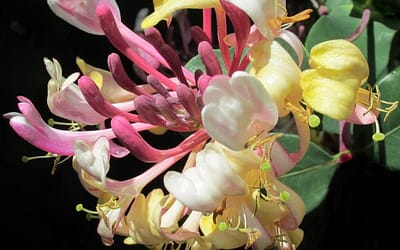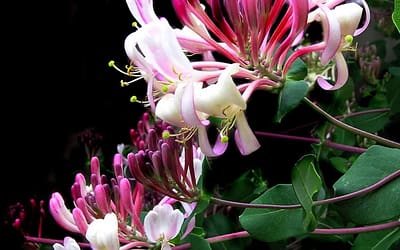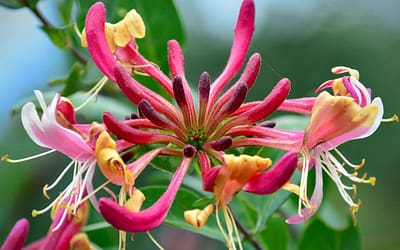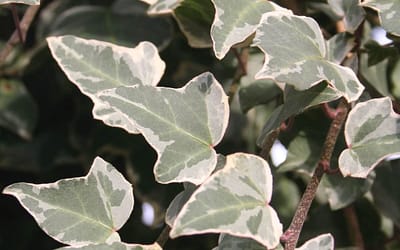Acacia dealbata: A Colourful Addition to Your Garden
Silver Wattle, Blue Wattle, Mimosa

Position
- Full sun: At least 6 hours of direct sunlight per day
- Sheltered from harsh winds
Hardiness
- Tolerates temperatures down to approximately -5°C (23°F)
Soil Type
- Well-drained soil; sandy or loamy soils are ideal
- Avoid heavy clay soils that retain water
Soil PH
- Slightly acidic to neutral (pH 6.0 to 7.5)
Height
- Typically reaches a height of 3-5 metres (10-16 feet)
Seasons of Interest
- Flowering Times:
- Flowers in early spring (March to May)
- Foliage:
- Silvery-green, feathery leaves
- No significant autumn colour change; leaves remain green and vibrant throughout the year
Acacia Dealbata: How to Grow and Care for Silver Wattle
Acacia dealbata, commonly known as the silver wattle, is a stunning shrub that brings year-round interest to any garden. This plant enhances outdoor space with its vibrant foliage and attractive flowers. Growing Acacia dealbata is relatively straightforward, making it a favourite among gardeners.
Characteristics of Acacia Dealbata
Originally native to Australia, Acacia dealbata has become popular in many regions for its striking appearance. Its silvery-green, feathery foliage creates a beautiful backdrop for the bright, golden-yellow flowers that bloom in early spring. These clusters of fluffy blooms not only provide visual interest but also attract beneficial insects.

Ideal Growing Conditions
Acacia thrives in warm climates. It prefers temperatures between 15°C to 30°C (59°F to 86°F). This plant loves full sun and can tolerate drought once established. However, ensure the soil is well-drained and rich in organic matter to achieve the best growth.
Planting Acacia Dealbata
Timing is essential when planting Acacia. The best time is in spring or autumn. You can start by choosing a location that receives at least six hours of sunlight daily.
- Soil Preparation: Test the soil pH; Acacia prefers slightly acidic to neutral soil, ideally between 6.0 and 7.5. Amend poor soil with compost to improve drainage and fertility.
- Digging the Hole: Prepare a hole twice the width of the root ball but only as deep as the root ball itself. This encourages healthy root growth.
- Planting: Place the shrub in the hole and backfill gently with soil, ensuring no air pockets remain. Water thoroughly to help settle the soil.
Watering
After planting, watering will be crucial in establishing your Acacia dealbata. Please ensure the soil stays moist but not soggy for the first year. As the plant matures, you can reduce the frequency of watering. Once established, Acacia dealbata is drought-tolerant, but occasional deep watering during dry spells promotes healthy growth.
Feeding
While Acacia dealbata does not require extensive feeding, a light application of a balanced fertiliser in spring can promote robust growth and blooming. Use organic options whenever possible to minimise environmental impact.
Pruning
Regular pruning helps maintain the shape of your Acacia. Prune lightly after flowering to remove spent blooms and shape the shrub. This promotes new growth and enhances air circulation, which helps prevent diseases. Reducing about one-third of the plant can encourage a bushier growth habit.
Pest and Disease Management
Like many plants, Acacia dealbata can be susceptible to pests such as aphids and scale. Please regularly look over your plants and treat infestations with insecticidal soap or neem oil as soon as possible. Also, please ensure good air circulation to minimise disease risks like powdery mildew.
Propagation
If you’re interested in propagating Acacia dealbata, you can do so through seeds or cuttings. Soak seeds in water for 24 hours before planting to improve germination rates. Sow seeds in spring in a well-draining mix and keep them warm and moist until they germinate.
For cuttings, take a 10-15 cm (4-6 inch) cutting from a healthy plant in late spring. Remove the lower leaves and dip the cutting in rooting hormone before placing it in a moist potting mix. Cover the pot with a plastic bag to maintain humidity until roots develop.

Landscaping Ideas
Acacia dealbata stands out beautifully in various landscaping settings. Use it as a focal point in a mixed shrub border or as part of a wildlife garden. Its flowers attract pollinators, making it an ideal addition to a garden that supports biodiversity.
Additionally, Acacia dealbata can benefit from companion planting. Pairing it with drought-tolerant plants, such as lavender or succulents, can create an attractive and low-maintenance landscape.
Seasonal Interest
Acacia provides visual appeal throughout the year. The bright yellow flowers create a stunning display in spring, while the foliage remains lush and silver-green throughout the summer. As autumn approaches, the leaves may turn a slightly deeper shade, maintaining the shrub’s attractiveness even as the seasons change.
Conclusion
Growing Acacia dealbata can enhance any garden with its striking colour and year-round interest. By providing the right conditions, proper care, and a little attention, you can enjoy the beauty of this vibrant shrub for years to come. Whether you’re a seasoned gardener or a beginner, Acacia dealbata offers an excellent opportunity to create an eye-catching landscape that will impress family and friends.
With its easy care requirements and year-long charm, Acacia truly deserves a place in your garden. Start your journey with this colourful shrub today, and watch it transform your outdoor space into a vibrant oasis.
If you’d like to explore Abelia’s care more, the RHS has an excellent article you can explore here.
For more information on Shrubs, please click here.
Frequently Asked Questions
Q: How tall does Acacia dealbata grow?
A: Acacia dealbata can reach 3-5 metres (10-16 feet) with a similar spread, depending on the growing conditions.
Q: What kind of soil does Acacia dealbata prefer?
A: It prefers well-drained, sandy soil. Avoid heavy clay and ensure good drainage to prevent root rot.
Q: How much sun does Acacia dealbata need?
A: It thrives in full sun but can tolerate slightly windy spots. Ensure it gets plenty of sunlight for optimal growth.
Q: When does Acacia dealbata flower?
A: It typically flowers from January to March, producing vibrant golden-yellow blooms that add colour to the landscape.
Q: Is Acacia dealbata deciduous or evergreen?
A: Acacia dealbata is an evergreen tree that maintains its foliage year-round.
Q: Can Acacia dealbata be grown in pots?
A: It can be grown in pots or large containers, especially in regions with harsh winters. This allows you to move the plant indoors for shelter during cold spells.
Q: How cold-hardy is Acacia dealbata?
A: It can withstand temperatures down to -5°C (23°F), especially if cold snaps are brief. However, it is less hardy in pots, so bring it indoors for winter protection.
Q: How often should I water Acacia dealbata?
A: It does not require frequent watering except during prolonged dry spells. Please make sure the soil remains moist but not waterlogged.
Q: Does Acacia dealbata need pruning?
A: Prune after flowering to maintain shape and encourage new growth. Avoid pruning in winter, as this may affect the next season’s blooms.
Q: What pests or diseases should I watch out for?
A: Acacia dealbata is generally resilient but occasionally attracts common garden pests. To prevent fungal issues, ensure good air circulation.
Q: Can I propagate Acacia dealbata from cuttings?
A: Yes, you can propagate it using cuttings taken in summer. Please place them in a well-draining medium and keep them moist until they root.
Q: How far apart should I plant multiple Acacia dealbata trees?
A: Space them approximately 3-4.5 metres (10-15 feet) apart to allow for mature spread and prevent overcrowding.
Q: Is Acacia dealbata suitable for coastal areas?
A: It is well-suited to Mediterranean and Atlantic coastal regions, where it thrives in milder climates and well-drained soil.
Q: Does Acacia dealbata produce seeds?
A: It produces seed pods that can be collected and sown to grow new plants. Scarify and soak the seeds before planting to improve germination.
Q: How do I care for Acacia dealbata in winter?
A: In mild climates, it can remain outdoors with a layer of mulch for root protection. Potted plants can be brought indoors in colder areas, or outdoor trees can be wrapped with horticultural fleece.
Q: Where can I buy Acacia dealbata?
A: Acacia dealbata is widely available at garden centres and online plant retailers. Check reputable suppliers for healthy, well-established plants.
Related Articles
Lonicera periclymenum Rhubarb and Custard
Honeysuckle Full sun to partial shade Any aspect - north, south, east, or west-facing Sheltered or exposed positions Ideal against walls, fences, or through trees Tolerates temperatures down to -20°C (-4°F) Fully hardy throughout UK Moist but well-drained soil Adapts...
Lonicera Belgica – Early Dutch Honeysuckle
Early Dutch Honeysuckle Partial shade to full sun North, south, east, or west-facing aspects Sheltered or exposed sites suitable Best against walls, fences, or climbing through trees Tolerates temperatures down to -20°C (-4°F) Fully hardy throughout UK Moist but...
Lonicera x heckrottii American Beauty
Honeysuckle Full sun to partial shade East, west, or south-facing aspects Sheltered or exposed locations suitable Fully hardy in UK climate Tolerates temperatures down to -15°C (5°F) Thrives in moist but well-drained soil Adaptable to clay and loam soils Suits acid,...
Lonicera Serotina – Late Dutch Honeysuckle
Late Dutch Honeysuckle Best in partial shade, though tolerates full sun Suitable for east, west, south, or north-facing aspects Can be grown in exposed or sheltered locations Fully hardy in UK climate Tolerates temperatures down to -20°C (-4°F) Adaptable to chalk,...
Lonicera periclymenum Strawberries and Cream
Honeysuckle Full sun to partial shade Sheltered from strong winds North, east, or west-facing walls suitable Fully hardy in UK climate Tolerates temperatures down to -15°C (5°F) Moist but well-drained Rich in organic matter Fertile loam ideal Adaptable to all soil...
Lonicera japonica Halls Prolific
Japanese Honeysuckle Full sun or partial shade South or west-facing aspect ideal Sheltered from strong winds Can grow in north-facing positions but may flower less Hardy down to -15°C (5°F) Semi-evergreen in mild winters, deciduous in harsh winters Moist but...
Lonicera x tellmanniana
Tellmann's Honeysuckle Prefers full sun or partial shade Ideal for a south-west facing position Should be sheltered from strong winds Roots enjoy cool conditions while the stems reach for sunlight Hardy down to -15°C to -10°C (5°F to 14°F) Thrives in moist but...
Lonicera periclymenum
Common Honeysuckle Prefers full sun to partial shade A sheltered spot is ideal to protect from harsh winds Can survive temperatures down to -15°C (5°F) Thrives in well-drained soil Can adapt to a range of soil types, including clay, loamy, and sandy soils Prefers...
Hedera helix Glacier
Glacier Ivy North, east, or west-facing walls Partial to full shade Sheltered from strong winds Can tolerate full sun in cooler areas Down to -15°C (5°F) Well-drained soil Medium moisture retention Rich in organic matter Clay, loam, or sandy soils all suitable Neutral...









